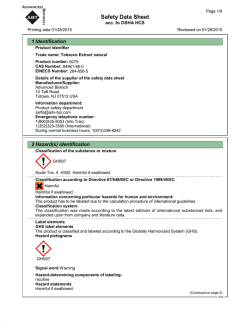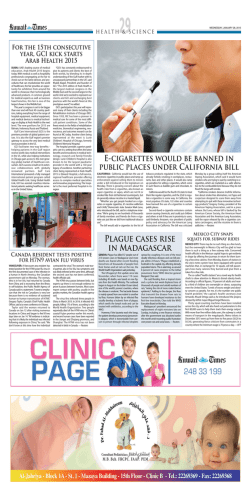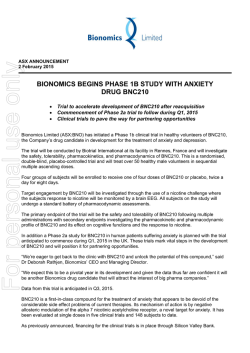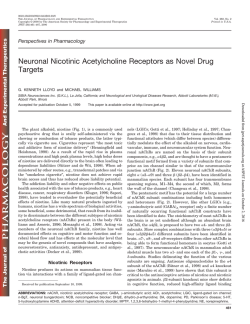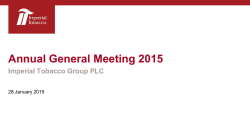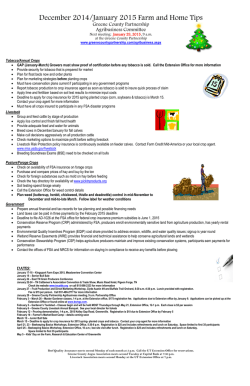
Nicotine Inhaling Products - Age of Sale - Consultation
Age of Sale for Nicotine Inhaling Products Consultation on proposed regulations to be made under the Children and Families Act 2014 December 2014 Contents 1. Purpose of this consultation................................................................................................. 4 2. Background ......................................................................................................................... 6 E-cigarettes .............................................................................................................................. 6 Licenced products .................................................................................................................... 7 Use of e-cigarettes ................................................................................................................... 7 Association with tobacco smoking ............................................................................................ 8 The effects of nicotine .............................................................................................................. 8 3. Detail of proposed regulations ........................................................................................... 10 Defining nicotine inhaling products ......................................................................................... 10 Medicinal products or medical devices ................................................................................... 10 Proxy purchase of e-cigarettes ............................................................................................... 11 Offences and penalties ........................................................................................................... 11 Age of sale .......................................................................................................................... 11 Proxy purchasing ................................................................................................................ 12 Enforcement ........................................................................................................................... 12 4. Territorial scope of the regulations .................................................................................... 12 5. Impact assessment ............................................................................................................ 12 6. How to get involved in the consultation ............................................................................. 13 7. Declaration of direct or indirect links to the tobacco industry by respondents ................... 14 8. Next steps.......................................................................................................................... 14 9. Comments on the consultation process ............................................................................. 14 10. Confidentiality of information ............................................................................................. 15 Annex A ..................................................................................................................................... 16 Draft regulations to be made under the Children and Families Act 2014 ............................... 16 Annex B ..................................................................................................................................... 19 Consultation questions about the proposed regulations and assessment of impact on business ................................................................................................................................. 19 December 2014 1. Purpose of this consultation 1.1. The purpose of this consultation is to seek views on draft regulations to introduce a minimum age of sale of 18 years for nicotine inhaling products, such as electronic cigarettes (also known as e-cigarettes) and related parts of such devices. 1.2. Given the emergence of e-cigarettes in recent years, coupled with concerns about the increased awareness and use of these products by children, the Government has committed to setting an age of sale requirement for these products. Section 92 of the Children and Families Act 2014 (‘the Act’) gives the Secretary of State the powers to make regulations to introduce a minimum age of sale for nicotine products. 1.3. A ‘nicotine inhaling product’ for the purposes of the proposed regulations means any device which is intended to enable nicotine to be inhaled through a mouthpiece. It encompasses e-cigarettes (disposable and non-disposable) and certain component parts such as nicotine refill cartridges and nicotine refill substances, often called ‘eliquids’. 1.4. The proposed regulations would not apply to tobacco products, because age of sale laws already exist. As the regulations would only apply to nicotine inhaling products, they would not cover other products where small amounts of nicotine occur naturally, such as certain fruits and vegetables. Nevertheless, the regulation-making powers enable the Government to make provision in the future for other nicotine delivery products which may emerge in time. 1.5. The aims of the proposed regulations would be to: • limit the sale of nicotine inhaling products such as e-cigarettes to adults only, with certain limited exceptions for medicinal products • protect children from the risk of nicotine addiction and the impact that nicotine can have on the developing adolescent brain • protect children and young people from any potential ‘gateway’ effect into smoking tobacco that might come from the use of nicotine inhaling products 1.6. The proposed regulations would: • make it an offence to sell nicotine inhaling products (such as e-cigarettes) and related products to anyone under the age of 18 years • extend the tobacco ‘proxy purchasing’ offence in the Act to also cover e-cigarettes, so it would also be an offence for an adult to buy a nicotine inhaling products on behalf of a person under 18 years • exempt the sale of any nicotine inhaling product that is licensed as a medicine, where it has been prescribed to the child or where the medicine is indicated for use by children 1.7. The proposed regulations are explained in more detail in section 3. 1.8. The age of sale regulations proposed in this consultation will apply to England and Wales, subject to the necessary consent being provided by Welsh Ministers. 1.9. The Government intends to proceed with the introduction of regulations to set an age of sale for nicotine inhaling products. This consultation seeks views on the detail of proposed regulations so that feedback from those with an interest can be considered December 2014 Age of Sale for Nicotine Inhaling Products before regulations are finalised. Parliament will consider the regulations before they can be made. 1.10. We are seeking views on the proposed regulations at Annex A and responses to the specific consultation questions at Annex B. 1.11. We also seek views on our initial assessment of the impact on business and the equality analysis which are published alongside this consultation document. 5 2. Background 2.1. In summary, the Government is introducing an age of sale restriction because: • children should be protected from the risk of addiction • the use of nicotine in adolescence can alter brain development • use and awareness of e-cigarettes among children is increasing • e-cigarettes can be appealing to children • we do not know conclusively whether e-cigarettes act as a ‘gateway’ into the use of tobacco • we do not know about the effect of the use of e-cigarettes on the developing lungs of children • the Government wishes to remove existing uncertainty on age of sale and provide clarity and consistency to assist manufacturers and retailers 2.2. The Government recognises that responsible manufacturers already recommend that their products are for use by adults only. Responsible retailers already voluntarily restrict children from accessing e-cigarettes. However, some do not. A number of manufacturers and retailers of e-cigarettes have called for a minimum age of sale to be introduced. 2.3. To support retailers to implement age of sale requirements for nicotine inhaling products, the proposed regulations have been developed to be consistent with existing age of sale requirements relating to the sale of tobacco and other age restricted products. E-cigarettes 2.4. In recent years, the market for e-cigarettes has developed rapidly. Today, a wide range of different types and brands of e-cigarettes are on the market. 2.5. According to a report on e-cigarettes commissioned by Public Health England (PHE), ecigarettes were invented in China in 2003 to provide inhaled doses of vaporized nicotine. E-cigarettes were first introduced to Europe in about 2005 and have become increasingly popular since. The products have evolved considerably. 1 Action on Smoking and Health (ASH) provides the following description of electronic cigarettes: Electronic cigarettes, also known as vapourisers or electronic nicotine delivery systems (ENDS), are often, although not always, designed to look and feel like cigarettes. They have been marketed as less harmful alternatives to cigarettes and for use in places where smoking is not permitted since they do not produce smoke. There are three main types of electronic cigarettes or vapourisers: • • • Disposable products (non-rechargeable) An electronic cigarette kit that is rechargeable with replaceable pre-filled cartridges An electronic cigarette that is rechargeable and has a tank or reservoir which has to be filled with liquid nicotine 6 Age of Sale for Nicotine Inhaling Products The first two types of electronic cigarette are often known as “cigalike” products as they resemble cigarettes and often have a light at the end that glows when the user draws on the device to resemble a lit cigarette. 2 2.6. Most e-cigarettes on the market are flavoured. A huge variety of flavours for ecigarettes are available, some of which may be appealing to children (such as cherry cola, white chocolate, bubble gum, vanilla ice cream, energy drink and gummy bear flavours). Licenced products 2.7. Nicotine inhaling products can only be marketed as a smoking cessation aid if they have been licensed as a medicine by the MHRA. 3 While a number of e-cigarette companies have said publicly that they have or will submit an application for a medicines licence for their products, at present a license has been granted for only two products that would meet the definition of nicotine inhaling products: Voke and the Nicorette Inhalator. 2.8. A nicotine inhaling product regulated as a medicine, such as a nicotine replacement therapy, would be available to be sold to children under the age of 18 years if (a) it is sold in accordance with a valid prescription (regardless of classification) or (b) the product’s medicine marketing authorisation provides that it is indicated for use by persons under 18 years. 2.9. Licensed medicines are subject to separate regulatory rules that cover aspects such as advertising, product presentation, to whom medicines can be supplied and other aspects relating to sale and supply. Use of e-cigarettes 2.10. E-cigarettes are becoming increasingly popular and are now widely promoted. ASH estimates that there are currently around 2.1 million adults in Great Britain using electronic cigarettes, up from an estimated 700,000 users in 2012. 4 While use of these products by people under the age of 18 is not widespread in England and Wales, international evidence suggests that it is plausible that usage of e-cigarettes by young people may increase. 2.11. Emerging evidence suggests that awareness of e-cigarettes by British children is high. A report commissioned by PHE on e-cigarette uptake and marketing found that twothirds (66%) of 11 to 18-year olds in Great Britain had heard of e-cigarettes. Some 7% had tried e-cigarettes at least once and 2% reported using them sometimes or often. A separate study found that over two-thirds of children in Wales reported that they have heard of e-cigarettes. 5 In a study conducted among children in Cheshire and Merseyside, all participating children had heard of e-cigarettes or knew what they were. This study also found: There was an overwhelming sense across all groups that the majority of young people who do use e-cigarettes do so not for the benefits proposed by those who produce and market these products (e.g. for health benefits, to save money, to allow users to intake nicotine in locations where tobacco smoking is prohibited), but simply “for the sake of it”, to fit in with or impress their peers, or to portray a certain desired image of themselves. 6 2.12. The promotion of e-cigarettes is likely to be a key reason why awareness of these products is high among children and young people. E-cigarettes are available for sale in a wide range of retail outlets, including supermarkets, newsagents, specialist shops and 7 pharmacies, and are often prominently displayed and promoted in store. E-cigarette companies compete on price and invest in marketing and promotion, including through social media such as Twitter. 7 E-cigarettes are widely advertised, which has become a cause of concern for some. 2.13. The Government recognises that responsible e-cigarette manufacturers will not seek specifically to market e-cigarettes to children. However, while e-cigarette companies may design much of their promotional activity to reach out to adults, there is a risk that this promotion may also resonate with young people. Young people are also exposed to increasing in-store marketing of e-cigarette products and it is plausible that the increasing prominence of e-cigarette marketing in shops may increase the appeal of these products. Association with tobacco smoking 2.14. While e-cigarette use by children is currently strongly associated with existing tobacco smoking, research published recently by the Welsh Government provides tentative evidence that e-cigarette use may represent a new form of childhood experimentation with nicotine.5 E-cigarette use might be more prevalent among 10-11 year olds than smoking. Some 6% of children in this group reported to have ever used an e-cigarette, compared with 2% who reported having ever smoked. Research in Cheshire and Merseyside found that young people view e‐cigarettes as products in their own right, rather than, for example, a substitute to smoking tobacco. This research suggests that many young people say that they use e-cigarettes “simply for the sake of it”, “for fun”, or to “try something new”, and that the main focus for young people was on the different flavours and designs of e‐cigarettes and the opportunity for users to customise their devices and show individuality. The researchers concluded that, with their colourful designs and variety of flavours, e-cigarettes may provide a more accessible and appealing way for young people who may not like the taste or sensation of tobacco cigarettes to experiment with nicotine. 8 E-cigarettes are likely to be easier to use than smoking conventional cigarettes. 2.15. In her 2013 Annual Report, the Chief Medical Officer for England ‘raises concern that there may be young people for whom e-cigarettes could be an entry point to use of conventional tobacco products, including cigarettes’. 9 As there have been no longitudinal studies to examine whether e-cigarettes serve as a gateway to tobacco use, we cannot be certain at this stage about whether there is a “gateway effect” from the use of e-cigarettes into tobacco smoking, and further research is needed to answer the question definitively. The World Health Organization has recently recommended that ecigarettes should not be sold to minors. The effects of nicotine 2.16. It has long been established that nicotine is highly addictive. Nicotine is a potent and powerfully addictive drug, which is five to ten times more potent than cocaine or morphine in producing behavioural and psychic effects associated with addiction potential in humans. 10 The Government wants to protect children and young people from addiction to any substance, particularly those that might be harmful. 2.17. Young people can rapidly develop nicotine dependence. With respect to nicotine from smoking tobacco, symptoms can develop soon after a young person’s first puff on a cigarette. Novice users often do not recognise the symptoms they experience as related to nicotine dependence. 11 Research shows that the adolescent brain continues to 8 Age of Sale for Nicotine Inhaling Products develop during adolescence and that it is uniquely different from the adult brain. One of the differences is that adolescents are more sensitive to the rewarding effects of nicotine, which may be a reason that many people start to smoke during adolescence. 12 The impact of nicotine on the developing adolescent brain, as delivered by e-cigarettes, is also described by Dutra et al. Although e-cigarettes deliver many fewer toxins and at much lower levels than conventional cigarettes, they contain nicotine, a highly addictive substance, in doses designed to mimic cigarettes. Animal models suggest that, through its effect on cholinergic pathways, nicotine may have permanent effects on the brain and behaviour such as dysregulation of the limbic system, which can lead to longterm difficulties with behavioural regulation, attention, memory, and motivation, among other functions. The adolescent human brain may be particularly vulnerable to the effects of nicotine because it is still developing. 13 9 3. Detail of proposed regulations 3.1. Regulations would be made in accordance with Section 92 of the Act. 14 The proposed regulations are set out in Annex A and should be read in conjunction with the Act. Defining nicotine inhaling products 3.2. The minimum age of sale of 18 years will apply to ‘nicotine inhaling products’. This definition covers all e-cigarette devices (including disposable and rechargeable types) and their refills (such as pre-filled refill cartridges and liquids). Within the proposed regulations, a ‘nicotine inhaling device’ covers any device which is intended to enable nicotine to be inhaled through a mouth piece. It would not matter whether the device looks like a conventional cigarette or takes a different form if a device meets the definition proposed. The regulations cover all nicotine inhaling products, regardless of how they are powered. ‘Dual use’ refillable devices which might alternatively be filled with either nicotine or non-nicotine liquid would also be subject to the age of sale requirements. 3.3. Some e-cigarettes do not look like conventional tobacco cigarettes and contain a reservoir or tank which is designed to be filled with a propylene glycol liquid. These liquids may be sold separately and may or may not contain nicotine. Although, at the point of sale, some devices may not contain nicotine, they would be covered by the proposed regulations if they are intended to enable nicotine to be inhaled through a mouthpiece. 3.4. The government does not intend for the proposed regulations to cover component parts such as batteries, charging devices and electrical leads for nicotine inhaling products. Medicinal products or medical devices 3.5. The regulations provide exemptions for any nicotine inhaling product that is licensed as a medicine by the Medicines and Healthcare Products Regulatory Agency (MHRA). Nicotine inhaling products that are licensed medicines can be made available to children and young people under the age of 18 years on prescription. The draft regulations also propose an exemption for any nicotine inhaling product which has an indication for use by people under the age of 18. 3.6. Regulation 4 would exempt the sale of nicotine inhaling products that are medicines or medical devices sold in accordance with a valid prescription by a pharmacist (or in other rare exceptional circumstances under which prescription only medicines could be sold). Regulation 5 would exempt from age of sale requirements the sale of any nicotine inhaling products that are authorised medicines with a licence as a non-prescription medicine which specifies that they are indicated for the treatment of persons aged under 18 years. In such cases, the seller may not need to be a pharmacist, as general sale list (GSL) medicines can be sold in any type of shop, subject to certain conditions being met. 3.7. Children under 18 years trying to quit smoking would continue to be able to access nicotine inhaling products that are licensed as medicines by way of a prescription, so the product would be used under medical supervision. As is currently the case, a person under 18 years would still be able to purchase certain nicotine inhaling products, such as the Nicorette Inhalator, in a newsagent or a supermarket, so long as the marketing 10 Age of Sale for Nicotine Inhaling Products authorisation for the medicine specifies that it is indicated for use by children under 18 years. 3.8. Other forms of nicotine replacement therapy medicines which are not intended to enable nicotine to be inhaled through a mouth piece, such as nicotine gums and patches, are not within the scope of these regulations. Proxy purchase of e-cigarettes 3.9. The regulations would extend the existing offence of the proxy purchase of tobacco products (at Section 91 of the Act) to cover nicotine inhaling products. 3.10. This would make it an offence for an adult to buy, or attempt to buy, a nicotine inhaling product on behalf of a child aged under 18 years, unless it has been prescribed to the child. This would bring the purchase of nicotine inhaling products such as e-cigarettes in line with equivalent offences for the proxy purchase of tobacco and alcohol and would bring consistency and clarity for retailers. 3.11. The proxy purchase offence could also apply to some nicotine inhaling products that are licensed as medicines. For example, where a product was licensed as a nonprescription medicine (i.e. as a GSL medicine) and was indicated for use only by people over the age of 18 years, it would be an offence for a person to buy, or attempt to buy, this product on behalf of a child under the age of 18. 3.12. As with the offence for tobacco, the adult making the purchase on behalf of the child would be committing the offence, not the retailer. Offences and penalties 3.13. The Act sets out the penalties which would apply where an offence is committed under the age of sale or proxy purchasing regulations. A person who does not comply with the law would be committing a criminal offence. Age of sale 3.14. Under the proposed regulations, an offence would be committed where someone sells a nicotine inhaling product to a person under the age of 18 years. 3.15. Under Section 91(5) of the Act, a person found guilty of an offence would be liable on summary conviction to a fine not exceeding level 4 on the standard scale. 15 This is consistent with the existing penalty for selling tobacco to persons under the age of 18. 3.16. Section 93 of the Act integrates the sale of nicotine inhaling products into the existing enforcement regime relating to the persistent sales of tobacco to children. A person or a business found to be repeatedly selling nicotine inhaling products to people under the age of 18 could receive a Restricted Sales Order or Restricted Premises Order from the court. Such an order prohibits a named individual, or a retail outlet, from selling nicotine inhaling products or tobacco to anyone for a period of up to one year. 3.17. Section 92(4) of the Act provides for a defence whereby the retailer is able to demonstrate that all reasonable steps were taken to avoid committing the offence. 11 Proxy purchasing 3.18. An offence will be committed by the adult who purchases, or attempts to purchase, a nicotine inhaling product as defined by the regulations on behalf of a person under 18 years. The Government proposes that enforcement officers could issue a Fixed Penalty Notice to an individual committing a proxy purchasing offence with respect to nicotine inhaling products. The fixed penalty amount is proposed to be £90 (£60 if payable within 15 days), which is consistent with the offence of proxy purchasing of alcohol. A person who receives a Fixed Penalty Notice could choose instead to have the matter dealt with by a court. A person who refuses or does not otherwise pay a Fixed Penalty Notice, may also be referred to court. Enforcement 3.19. Local authority trading standards officers would be responsible for enforcement of the proposed regulations, and they may be assisted by the police as necessary. 3.20. To facilitate effective and consistent enforcement, Regulation 6 would bring the age of sale offence for nicotine inhaling products within the scope of the Primary Authority Scheme. Further information on the Primary Authority arrangements can be found on the internet at: https://www.gov.uk/government/publications/primary-authority-overview 3.21. In addition, the age of sale and proxy purchase offences will be added to the list of offences in the Regulation of Investigatory Powers Act (RIPA) 2000. This will enable local authority enforcement officers to apply to use “directed surveillance” to facilitate effective enforcement, subject to existing safeguards. Directed surveillance means surveillance which is covert and is likely to result in the obtaining of private information. 4. Territorial scope of the regulations 4.1. The regulations would apply to England and Wales only. 5. Impact assessment 5.1. A consultation-stage impact assessment (IA) has been prepared and is published alongside this consultation document. A number of consultation questions specifically related to the IA are at Annex B. We would welcome comments on the IA and any further evidence or information which would enable us to further elaborate the IA. 5.2. We have also published an initial assessment of the impact on equality, which is published alongside this consultation document and we welcome any additional information in relation to how these proposals can contribute to us fulfilling our public sector duties under the Equality Act 2010. 16 12 Age of Sale for Nicotine Inhaling Products 6. How to get involved in the consultation 6.1. The consultation questions are set out at Annex B. The consultation will run for 6 weeks, from 17 December 2014 to 23:45 on 28 January 2015. We welcome responses from any interested person, organisation or business. 6.2. Respondents are encouraged to provide their views online but responses can be made in any of the following ways: • Completing the online form at: http://consultations.dh.gov.uk/tobacco/age-of-sale-for-nicotine-products • Filling in the response form by downloading it at: www.gov.uk/government/consultations • Emailing your response to: [email protected] • Posting your response to: Age of Sale Consultation Department of Health 6th Floor, Wellington House 133-155 Waterloo Road London SE1 8UG 6.3. The purpose of this consultation is to seek the views of interested people, organisations and businesses on the draft regulations to introduce age of sale requirements for nicotine inhaling products and how these provisions would work in practice. We ask that you provide references to research or other evidence with your responses. 6.4. If you wish to get a copy of this consultation document in an alternative format, or need to respond in an alternative format for accessibility reasons, please contact us using the email or postal addresses given in paragraph 6.2. 6.5. The Department of Health will not be able to respond specifically to individual consultation responses. 13 7. Declaration of direct or indirect links to the tobacco industry by respondents 7.1. As a Party to the World Health Organization’s Framework Convention on Tobacco Control (FCTC), the United Kingdom has an obligation to protect the development of public health policy from the vested interests of the tobacco industry. To meet this obligation, we ask all respondents to disclose whether they have any direct or indirect links to, or receive funding from, the tobacco industry. We will still carefully consider all consultation responses from the tobacco industry and from those with links to the industry, and include them in the published summary of consultation responses. 8. Next steps 8.1. All responses received by 23:45 on the closing date of 28 January 2015 will be carefully considered. A summary report of consultation responses will be published on the Department of Health website in due course after the completion of the consultation. 8.2. A final decision will be made on the content of the regulations. Subject to Parliamentary approval, we are planning for the regulations to come into force in 2015. 9. Comments on the consultation process 9.1. If you have concerns or comments which you would like to make relating specifically to the consultation process itself please contact Consultations Coordinator Department of Health 2E26, Quarry House Leeds LS2 7UE e-mail: [email protected] 9.2. Please do not send consultation responses to this address. 14 Age of Sale for Nicotine Inhaling Products 10. Confidentiality of information 10.1. We will manage the information you provide in response to this consultation in accordance with the Department of Health Information Charter. 17 10.2. Please be aware that, under the Freedom of Information Act, there is a statutory Code of Practice with which public authorities must comply and which deals, amongst other things, with obligations of confidence. If you want the information that you provide to be treated as confidential, it would be helpful if you could explain to us why you regard the information you have provided as confidential. If we receive a request for disclosure of the information we will take full account of your explanation, but we cannot give an assurance that confidentiality can be maintained in all circumstances. An automatic confidentiality disclaimer generated by your IT system will not, of itself, be regarded as binding on the Department. 10.3. The Department will process your personal data in accordance with the Data Protection Act and in most circumstances this will mean that your personal data will not be disclosed to third parties. 15 Annex A Draft regulations to be made under the Children and Families Act 2014 Draft Regulations laid before Parliament under section 135(6) of the Children and Families Act 2014, for approval by resolution of each House of Parliament. DRAFT STATUTORY INSTRUMENTS 20xx No.xxx PUBLIC HEALTH, ENGLAND AND WALES The Nicotine Inhaling Products (Age of Sale and Proxy Purchasing) Regulations 20xx Made - - - - *** Coming into force Regulations 1 and 2 … Regulations 3 to 6 … The Secretary of State makes the following regulations in exercise of the powers conferred by sections 92(1), (6) and (7) and 93(8) of the Children and Families Act 2015( 1). In accordance with section 135(6) of that Act, a draft of this instrument has been laid before Parliament and approved by resolution of each House of Parliament. In accordance with section 92(8) of that Act, the Secretary of State makes this instrument with the consent of the Welsh Ministers. Citation, commencement and interpretation 1.—(1) These Regulations may be cited as the Nicotine Inhaling Products (Age of Sale and Proxy Purchasing) Regulations 20xx. (2) Regulations 1 and 2 come into force on …. (3) Regulations 3 to 6 come into force on ….. (4) In these Regulations— “marketing authorisation” has the meaning given by regulation 8(1) of the Human Medicines Regulations 2012( 2); (1) 2 () 2014 c.6. See section 92(12) for the meaning of “specified”. S.I. 2012/1916. Relevant amendments were made by S.I. 2013/235, 1855, 2593, 2014/490, 1878. 16 “medical device” has the meaning given by regulation 2(1) of the Medical Devices Regulations 2002(3); “medicinal product” has the meaning given by regulation 2(1) of the Human Medicines Regulations 2012; “nicotine cartridge” means a cartridge which— (a) contains a substance which is not tobacco but consists of, or contains, nicotine; and (b) is intended to form part of a nicotine inhaling device; “nicotine inhaling device” means a device which— (a) is intended to enable nicotine to be inhaled through a mouth piece (regardless of whether the device is also intended to enable any other substance to be inhaled through a mouth piece); but (b) is not tobacco(4), cigarette papers or a device intended for the consumption of lit tobacco; “nicotine inhaling product” means a nicotine inhaling device, nicotine cartridge or nicotine refill substance; “nicotine refill substance” means a substance which— (a) is not tobacco but consists of or contains nicotine; and (b) is intended to be used to refill a nicotine inhaling device; “parallel import licence” has the meaning given by regulation 48(2) of the Human Medicines Regulations 2012; “prescription only medicine” has the meaning given by regulation 8(1) of the Human Medicines Regulations 2012. Proxy purchase of nicotine products 2.—(1) Section 91 of the Children and Families Act 2014 (purchase of tobacco etc. on behalf of persons under 18) is amended in accordance with paragraphs (2) to (4). (2) In the heading, before “etc.” insert “nicotine products”. (3) In subsection (1), for “or cigarette papers” substitute “cigarette papers or a relevant nicotine product”. (4) After subsection (7) add— “(8) In this section “relevant nicotine product” means a nicotine product within the meaning of section 92 the sale of which at the same time and in the same circumstances to the individual aged under 18 would be prohibited by regulations for the time being in force under subsection (1) of that section.” Prohibition of sale of nicotine inhaling products to persons aged under 18 3. — The sale of nicotine inhaling products to persons aged under 18 is prohibited, except where regulation 4 or 5 applies. Exception for sales of medicines and medical devices in accordance with a prescription etc. 4.—(1) This regulation applies to the sale of a nicotine inhaling product where— (a) the nicotine inhaling product is a medicinal product or a medical device; and (b) the circumstances of the sale are such that it would be permitted under Part 12 of the Human Medicines Regulations 2012 (dealings with medicinal products) if the nicotine inhaling product were a prescription only medicine. (2) For the purposes of sub-paragraph (1)(b), Part 12 of the Human Medicines Regulations 2012 is to be read as if regulation 244 (exemption in cases involving another’s default) were omitted. Exception for medicines indicated for the treatment of persons aged under 18 5.—(1) — This regulation applies to the sale of a nicotine inhaling product which— (3) S.I. 2002/618. Relevant amendments were made by S.I 2008/2936. (4) See the definition of “tobacco” at section 92(12) of the Children and Families Act 2014. December 2014 (a) is an authorised medicinal product; and (b) is indicated for the treatment of persons of the age of the person to whom the product is sold. (2) For the purposes of this regulation— (a) a product is indicated for the treatment of persons of a particular age if that indication is described in the summary of the product characteristics for the product in accordance with paragraph 27 of Schedule 8 to the Human Medicines Regulations 2012 (summary of the product characteristics) or Article 11 of Directive 2001/83/EC( 5); (b) “the summary of the product characteristics” is to be construed in accordance with Article 11 of Directive 2001/83/EC; (c) a medicinal product is “authorised” if one of the following is in force for the product— (i) a marketing authorisation; or (ii) a parallel import licence. Amendment of Schedule 3 to the Regulatory Enforcement and Sanctions Act 2008 6. — In Schedule 3( 6) to the Regulatory Enforcement and Sanctions Act 2008( 7) (enactments specified for the purposes of Part 1), at the appropriate place insert— “Children and Families Act 2014 (c.6), section 92”. Signed by authority of the Secretary of State (5) Directive 2001/83/EC of the European Parliament and of the Council of 6 November 2001 on the Community code relating to medicinal products for human use. OJ No L 311, 28.11.2001 (6) Schedule 3 was amended by Part 4 of Schedule 22 to the Marine and Costal Access Act 2009 (c.23), paragraphs 97 and 99 of Schedule 26 and Part 1 of Schedule 27 to the Equality Act 2010 (c. 15) (as amended by SI 2010/2279, Schedule 1, paragraph 6 and Schedule 2), paragraph 130 of Schedule 7 to the Charities Act 2011 (c. 25), paragraph 4(1) and (2) of Schedule 6 and Part 1 of Schedule 8 to S.I. 2010/2960, section 19(2) of the Scrap Metal Dealers Act 2013 (c.10), paragraphs 12 and 13 of Part 1 of the Schedule to S.I. 2013/1575, regulation 2 of S.I. 2013/2215 and paragraph 10 of Schedule 4 to the Mobile Homes (Wales) Act 2013 (anaw 6). (7) 2008 c.13. 18 Age of Sale for Nicotine Inhaling Products Annex B Consultation questions about the proposed regulations and assessment of impact on business 1. Do you have any comments regarding the definition of nicotine inhaling products proposed in the regulations? 2. Do you have any comments regarding the proposals for nicotine inhaling products that are medicines or medical devices? 3. Do you have any comments regarding the enforcement arrangements proposed in the regulations, or any views or evidence on enforcement costs? 4. Do you have any comments on the proposal to extend the current proxy purchase offence for tobacco to cover nicotine inhaling products? 5. Do you have any additional evidence on the use of e-cigarettes by under 18s as a gateway in or out of smoking? For example, how a minimum age of sale for e-cigarettes would impact on current users aged under 18? 6. Do you have any additional evidence that restricting the sale of nicotine inhaling products would contribute to reducing health inequalities and/or help us fulfil our duties under the Equality Act 2010? 7. Do you have any information or evidence that would inform the consultation-stage impact assessment? We particularly welcome any evidence or information which would improve any of the assumptions or estimates we have made in terms of the impact on retailers, manufacturers and distributers, including our assessment of any loss of profits. 8. Do you have any information or evidence that would improve any of the assumptions we have made in terms of the impact of these proposed regulations on small and micro businesses? 9. Is there anything else you wish to tell us that you think would improve the draft regulations? 19 1 Britton, J. and Bogdanovica, I. (2014). Electronic cigarettes: A report commissioned by Public Health England. Available at: www.gov.uk/government/uploads/system/uploads/attachment_data/file/311887/Ecigarettes_report.pdf 2 Action on Smoking and Health (2014). ASH briefing: E-cigarettes. Available at: www.ash.org.uk/files/documents/ASH_715.pdf 3 The Stationery Office (2012). The Human Medicines Regulations 2012 (SI 2012/1916) 4 Action on Smoking and Health (2014). ASH briefing: Use of electronic cigarettes in Great Britain. Available at: www.ash.org.uk/files/documents/ASH_891.pdf 5 Welsh Government (2014) Exposure to secondhand smoking in cars and e-cigarettes use among 10-11 year old children in Wales:CHETS Wales 2 key findings report. 6 Hardcastle, K. and Bennett, A. (2014). “Most people I know have got one”: Young people’s perceptions and experiences of electronic cigarettes. Centre for Public Health at Liverpool John Moores University, Liverpool. 7 Juang, J. et al. (2014). “A cross-sectional examination of marketing of electronic cigarettes on Twitter” in Tobacco Control 2014; 23, pp.iii26-iii30. 8 Hardcastle, K. and Bennett, A. (2014). “Most people I know have got one”: Young people’s perceptions and experiences of electronic cigarettes. Centre for Public Health at Liverpool John Moores University, Liverpool. 9 Davies, S. (2013). Annual Report of the Chief Medical Officer 2012 – Our Children Deserve Better: Prevention Pays. Department of Health, London. Available at: www.gov.uk/government/uploads/system/uploads/attachment_data/file/255237/2901304_CMO_complete_low_res_acc essible.pdf 10 Royal College of Physicans. (2007). Harm Reduction in Nicotine Addiction: Helping People who can’t quit. RCP, London. 11 Gervais, A., et al. (2006). “Milestones in the natural course of onset of cigarette use among adolescents”. Canadian Medical Association Journal. 175(3), pp.255-261. 12 Counotte, D. et al. (2011). “Development of the motivational system during adolescence, and its sensitivity to disruption by nicotine” in Developmental Cognitive Neuroscience; 2011; 1 (2011), pp.430-443. 13 Dutra, L. and Glantz, S. (2014). “Electronic Cigarettes and Conventional Cigarette Use Among US AdolescentsA Cross-sectional Study” in JAMA Pediatrics 2014; 168(7), pp.610-617. 14 Available at: www.legislation.gov.uk/ukpga/2014/6/section/92 15 The value of the fine at level 4 is currently up to £2,500. 16 Bodies subject to the Equality Duty must, when delivering their services and performing their functions, have due regard to the need to: • Eliminate unlawful discrimination, harassment, victimisation and any other conduct prohibited by the Act; • Advance equality of opportunity between people who share a particular protected characteristic and people who do not share it; and • Foster good relations between people who share a particular protected characteristic and people who do not share it. The public sector equality duty covers the protected characteristics of age, disability, gender reassignment, pregnancy and maternity, race (includes ethnic or national origins, colour or nationality), religion or belief (includes lack of belief), sex and sexual orientation. It also applies to marriage and civil partnership status, but only in respect of the requirement to have due regard to the need to eliminate discrimination. 17 Available at: www.gov.uk/government/organisations/department-of-health/about/personal-information-charter 20
© Copyright 2024
